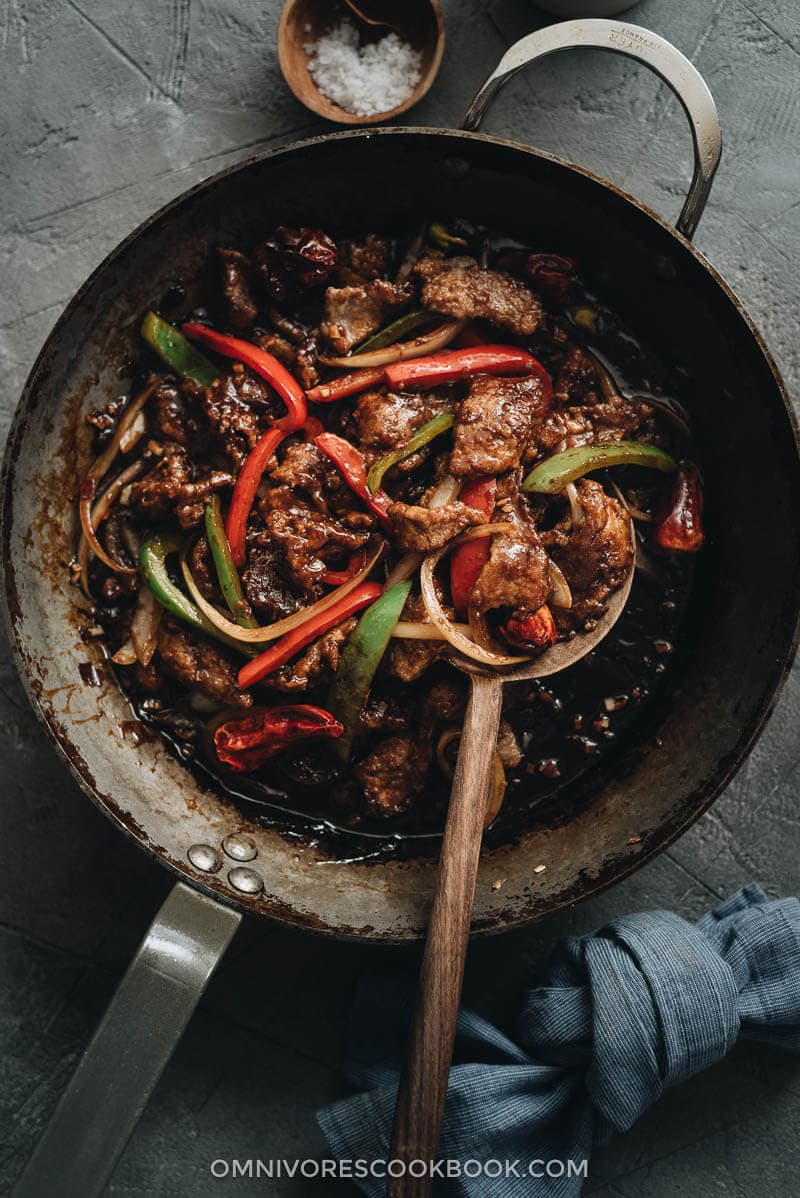
While a lot of Chinese recipes call for a wok and gas stove to make stir fry, I tend to disagree. Because this setup might not be practical for every home cook. As a personal example, I live in an apartment that has an electric stove, and it never generates heat fast enough for wok cooking.
After doing so many experiments with an electric stove, I finally found my own formula to create the best Chinese takeout dishes using a very simple setup with a nonstick skillet. Even better, my recipes do not require a ton of oil to deep fry the meat to create the crispy crust. For example, I’ve successfully recreated the restaurant version of Orange Chicken and Sesame Chicken without deep frying and simply use a nonstick skillet.
Today I want to share this Szechuan beef stir fry recipe. It requires a very simple setup and does not require deep frying. But it generates a result that’s even better than takeout. The beef is crispy on the outside and tender on the inside. The sauce is extra rich and full of aroma. Serve it on some steamed rice and your dinner will be ready!
Now let’s jump into the cooking process so you can learn all the secrets.
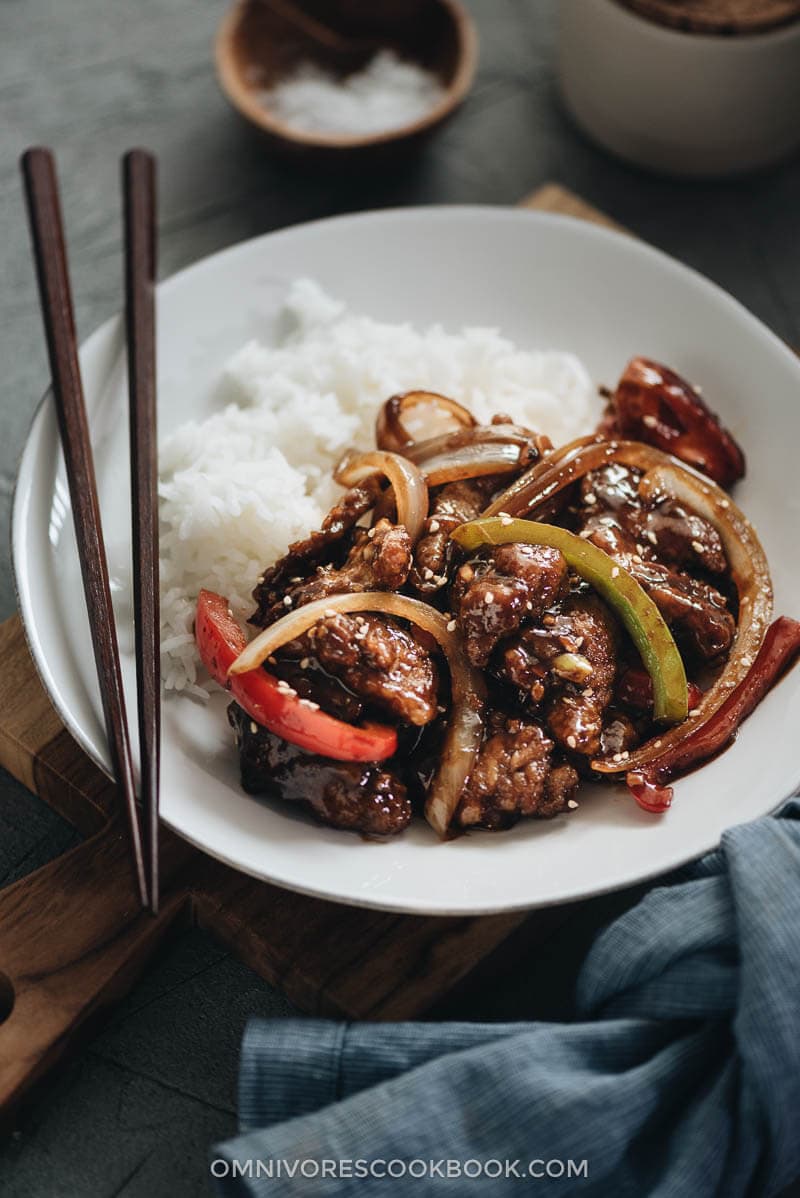
Szechuan Beef Cooking notes
1. Best cuts of beef to make stir fry
My favorite cut of beef for stir frying is flank steak. The cut is very tender and lean, and has just the right amount of marbling to keep it extra juicy. And it’s way cheaper than fancier cuts, such as tenderloin or ribeye. On the other hand, if you live in a place where flank steak is difficult to find or expensive, you can replace it with skirt steak or fajita cuts.
For an even cheaper alternative, you can use chuck roast or brisket. But remember, these cuts can be quite tough when stir fried. In this case, you should use the formula in my Orange Beef recipe, where I use baking soda to further tenderize the meat to create the desired soft texture. This is a practice that many Chinese restaurants use to create extra-tender beef with cheap cuts.
2. How to slice the beef for stir fry
Always slice against the grain, and try to create even thickness and size with your cuts. This is the foundation to creating tender meat in a stir fry.
In the pictures below, I demonstrate my approach to slicing a chunk of flank steak. First, I identify the direction of the grain. Then I slice along the muscle lines to create 3 small strips. And I cut perpendicular to the grain of each strip, to create evenly sized slices that are about 1/8” (4mm) thick and 2” (5cm) long.
It’s OK if you slice the beef slightly thicker. As long as it has a consistent thickness, the stir fry results will be consistent, without any overcooked or undercooked pieces.
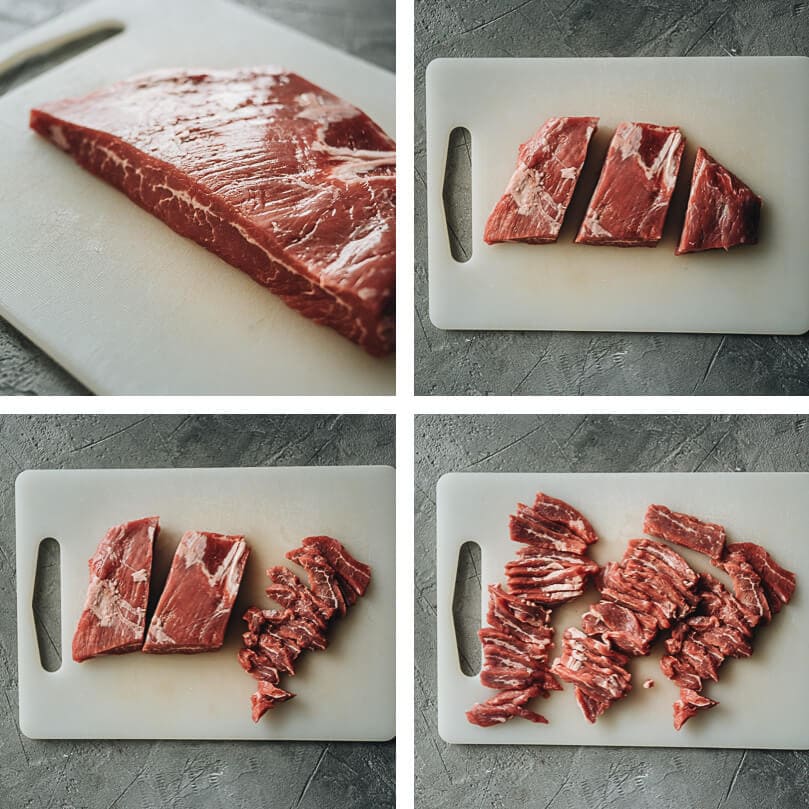
3. The secret formula to create crispy tender beef without deep-frying
Chinese restaurant usually deep fry the beef to create that heavenly crust. But that uses tons of oil and does require a wok. Not so practical in a home kitchen.
Here is a much easier approach.
The first step is to marinate the beef, which helps season and tenderize the beef. Then I coat the beef with extra cornstarch and pan fry it in a thin layer of oil. The combination of egg and cornstarch will create a crispy crust with minimal oil. You can probably get away with 1/4 cup of oil with a nonstick pan, or 1/3 of a cup of oil if using a cast iron or carbon steel pan.
It’s important to mix in the cornstarch right before you cook. Also, you should heat up the pan and the oil very well, until it is almost about to smoke.
Then you can add all the pieces into the pan and spread them out using a pair of tongs and your spatula. I personally prefer to use a pair of chopsticks to spread out the meat, to ensure that the beef slices are in contact with the hot pan. Remember, you should always leave the meat to sear in the pan without touching it, until the bottom is browned. It creates a better crust and minimizes sticking if you’re using a cast iron pan.
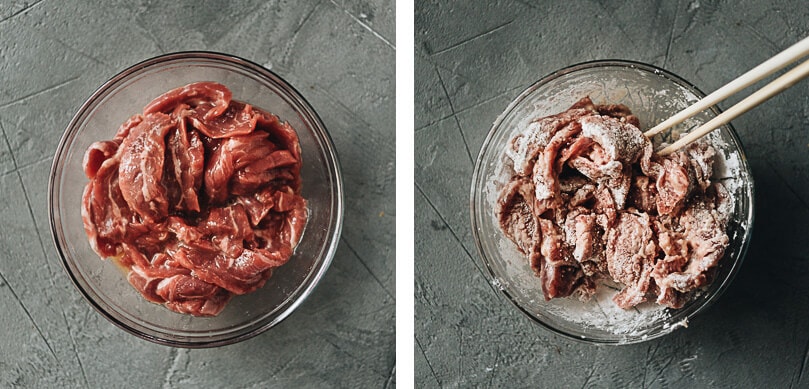
4. Extra rich Szechuan sauce
The two secret ingredients I use are Doubanjiang and homemade chili oil.
Doubanjiang (豆瓣酱), also called fermented spicy bean paste, is not your average hot sauce. It is a super rich, fermented, spicy paste made with dried fava beans, fresh chili peppers, salt, and wheat flour, then aged for between one and eight years. Doubanjiang has a deep savory, spicy and quite salty taste. It is a key ingredient in classic Sichuan dishes such as Mapo Tofu, Sichuan Eggplant Stir Fry, Sichuan Beef in Hot Broth, and Sichuan Fish with Pickled Mustard Greens. I use this ingredient to add spiciness and extra umami to the sauce. You can find it on Amazon or at The Mala Market.
Homemade chili oil is another booster to give the sauce a better aroma. However I do list it as an option, because you can skip it if you like your dish less spicy.
If you don’t have Doubanjiang, you can use another hot sauce as an alternative. For example, sambal oelek or sriracha. But do note that although the properties of the Szechuan sauce will change, it will still result in a delicious flavor.
5. Efficient workflow
This Szechuan beef recipe might look quite long and intimidating, but it actually only includes four steps:
- Slice the beef and marinate it.
- Mix the sauce.
- Chop the rest of the ingredients, such as aromatics and veggies.
- Make the stir fry.
Before you start cooking, you should have these bowls ready near your stove:
Marinated beef coated with cornstarch, a bowl of chopped ginger and garlic, a plate of chopped onion and pepper, mixed sauce, and dried chili peppers.
If you organize your ingredients in groups, the stir fry process will be so much easier.
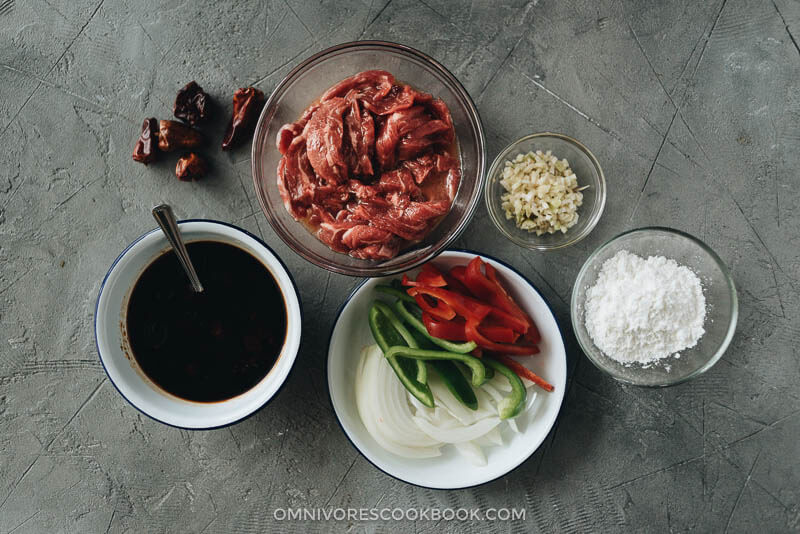

6. Add different veggies to your meal
You can replace the peppers with other types of veggies. Here is a simple way to add more greens to your table. You can use a small head of broccoli (seperated into bite-size florets), 2 cups of green beans, 4 cups of kale (chopped), or 1/2 lb spinach. Add the veggies into a big bowl and cover with plastic wrap. Heat them in the microwave in 1-minute increments, until the plastic expands, or until the veggies are cooked to your desired texture. It usually requires 1 to 2 minutes for leafy greens and up to 4 minutes for harder veggies.
Simply serve the microwave steamed veggies on the side and pour the beef and sauce over them. This recipe creates quite a saucy dish, so you will have plenty of sauce to cover the veggies.
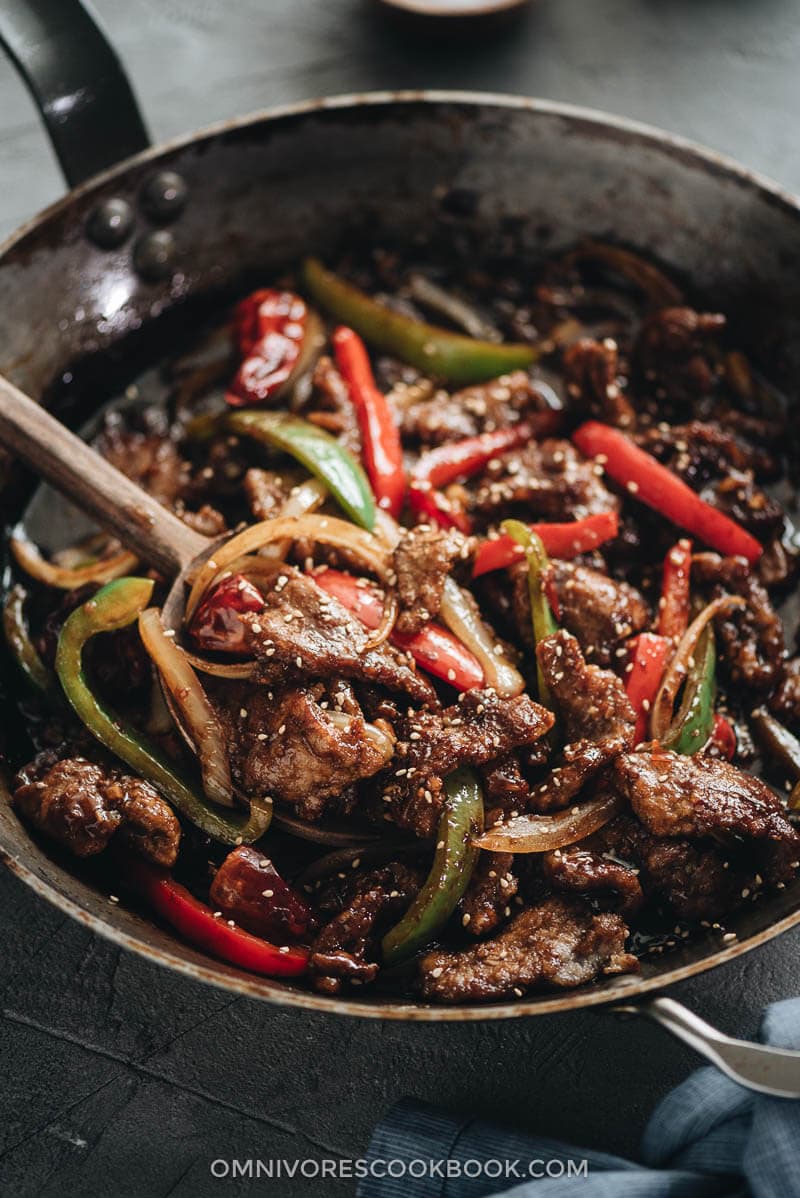
More homemade takeout recipes
If you give this recipe a try, let us know! Leave a comment, rate it (once you’ve tried it), and take a picture and tag it @omnivorescookbook on Instagram! I’d love to see what you come up with.
Chinese Cooking Made Easy
Are you new to this website? This free email series is a great place to start. I’ll walk you through a few of my most popular recipes and show you how and why they work. You’ll quickly start to cook better Chinese food in your own kitchen.
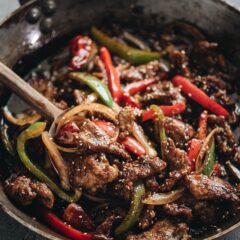
Real-Deal Szechuan Beef Stir Fry
Ingredients
Marinade
- 1 lb flank steak , cut against the grain to 1/8” (4-mm) slices (*Footnote 1)
- 1 egg , beaten
- 1 tablespoon peanut oil (or vegetable oil)
- 1/2 teaspoon salt
Sauce
- 3 tablespoons Chinkiang vinegar (*Footnote 2)
- 2 tablespoons Shaoxing wine
- 1 tablespoon light soy sauce (or soy sauce)
- 1 tablespoon dark soy sauce (or soy sauce) (*Footnote 3)
- 1 tablespoon homemade chili oil (Optional)
- 1 tablespoon Doubanjiang (fermented chili bean paste) (*Footnote 4)
- 1/2 cup beef stock (or water)
- 3 tablespoons sugar
- 1 tablespoon cornstarch
Stir-fry
- 1/3 cup cornstarch
- 1/3 cup peanut oil (or vegetable oil)
- 1/4 white onion , sliced
- 1 bell pepper , thinly sliced (I used half red and half green)
- 4 Chinese dried chili peppers
- 1 tablespoon ginger , minced
- 1 tablespoon garlic , minced
- Roasted sesame seeds for garnish (Optional)
Instructions
Marinate the beef
- Beat the egg in a medium sized bowl. Add the sliced beef, vegetable oil, and salt. Mix well and let marinate for 15 to 20 minutes while preparing the other ingredients.
Mix the sauce
- Combine everything for the sauce in a big bowl and mix well.
Stir fry
- When you’re ready to cook, drain the extra liquid from the bowl of beef. Add the cornstarch. Stir to coat the beef, until it forms an uneven coating with a little dry cornstarch left unattached.
- Heat oil in a large nonstick skillet (or a cast iron pan) over medium high heat until hot. Add the beef and spread into a single layer in the skillet. Separate the beef pieces with a pair of tongs or chopsticks.
- Cook without touching the beef for 2 to 3 minutes, or until the bottom turns golden. Flip to brown the other side, 1 to 2 minutes. Transfer the beef to a big plate and remove the pan from the stove. Let cool for 2 to 3 minutes.
- Place the pan back onto the stove and turn to medium heat. You should still have 1 to 2 tablespoons of oil in the pan. If not, add more.
- Add the onion, pepper, and dried chili pepper. Cook and stir for 1 minute.
- Add the ginger and garlic. Stir a few times to release the fragrance.
- Stir the sauce again to dissolve the cornstarch completely. Pour into the pan. Stir and cook until it thickens a bit.
- Add back the beef pieces. Stir to coat beef with sauce.
- Transfer everything to a plate immediately and garnish with roasted sesame seeds, if using.
- Serve hot over steamed rice as a main dish.
Notes
- To make the dish gluten-free, use rice vinegar to replace Chinkiang vinegar, tamari or coconut aminos to replace soy sauce, and a gluten-free hot sauce such as Sriracha to replace the Doubanjiang.
- Flank steak is my favorite cut for this dish, but you can use skirt steak, short ribs, or fajita meat, as well. If you decide to use a cheaper cut, such as as brisket or chuck roast, refer to my Orange Beef recipe to see how to tenderize the meat using baking soda.
- You can use rice vinegar as an alternative, although the sauce will come out slightly different and less pungent.
- Dark soy sauce will add a beautiful caramel color to the beef. You can use regular soy sauce as well but the dish will come out with a lighter color.
- You can use other hot sauces such as Sriracha, sambal oelek, etc. The sauce will come out differently but still be tasty.
Nutrition

Did you make this recipe?
I’d love to hear how it turned out for you! Please take a moment to leave a 5-star rating ⭐️ and share your thoughts in the comments further down the page. It really helps others discover the recipe too.

Will H
This recipe was absolutely brilliant. Just exceptional – genuinely tasted like a decent Chinese takeaway except better because of the quality of the beef and the fact it wasn’t overcooked. I would add a little more chilli oil and more dried chillis than the recipe but I like it quite hot.
Benson J Burns
Absolutely loved this recipe. Thank you for sharing.
Peter Beckles
Today was another Szechuan Beef Stir Fry day.
I’m getting better at this thing: got all the bits and pieces together and got everything done while the rice was cooking!
Can’t get the beef crispy outside yet but I’ll get there.
Cheers,
Peter Beckles
I forgot to ask: Does doubanjiang have to be refrigerated after the bottle has been opened?
Maggie
Hi Peter, doubanjiang can be stored at room temperature for quite some time due to its saltiness, but I do store it in the fridge to keep the maximum freshness.
Peter Beckles
Here was my opportunity to use my new bottle of doubanjiang.
Great sheen on the sauce; great flavour and just the right zing.
I even prepared some broccoli stems and toasted sesame seeds but forgot both!!
Next time.
Cheers
Melissa Plummer
so good!
Bill Wieners
I didn’t have all the ingredients exact, but that marinade was a great idea. I’ve tried other versions of this dish, but I never had the meat come out as crispy and well cooked. I will try to find more of the actual ingredients for next time, but I am certainly saving this recipe.
Jim
Maggie, what’s the Chinese name for “flank steak?” That would help find this cut of beef here in Taiwan. Thanks.
Maggie
I think it is 侧腹牛排 in Chinese.
Michael Moehler
Great Receipe!!! I tried different Receipe from you, and all where great😀👍
Thanks a lot,
Michael from Bavaria, Germany
Casey Glovin
I made this with some minor alterations due to a lack of resources. Despite that, it was AMAZING! My husband, whose mother is a gourmet chef, said this could easily be a $30 dish at a nice restaurant. The key is the cornstarch on the beef prior to cooking! Thank you for posting!
Pablo
This is an amazing recipe. It looks a lot harder than it is. Even substituting for the hard to find ingredients it turned out ridiculously good. Beef is super crispy and really holds the sauce beautifully. I always make more sauce than recommended just because I like to have extra. I ordered the actual ingredients she recommends because I really want too try it the way it was intended but for the first run I just used your standard rice wine and rice vinegar and substituted Gochujang because it was already in the house. I did make a homemade chili oil but again used what I could find locally until the actual ingredients arrive. Add this to your list of go to meals. You won’t regret it.
Leia
I made this for my husband’s birthday and we both LOVED it! Thank you for sharing!
Aastha
Hi,
Can we try this recipe with lamb/chicken/pork?
Aastha
Maggie
Hi Aastha, yes, I’m sure you can replace the beef with lamb/chicken/pork and the result will be tasty!
Chrissie Stevens
I totally didn’t have 80% of ingredients, I wasn’t expecting to make this but had a house full & just a few sirloin steaks. But it turned out fantastic kinda crispy but still moist. Even the two little ones enjoyed it. Thanks for a keeper recipe
Sashi Sehgal
This recipe is just amazing. What we loved about it was the amazing zing that came from it. So well flavoured. It’s turned int9 a favourite at home. Thanks again Maggie, great recipe!
Richard
Where are the Sichuan peppercorns in this recipe? Not authentic Sichuan without them.
Maggie
Hi Richard, my homemade chili oil uses Sichuan peppercorns. The flavor profile of this recipe borrowed from “Yu Xiang Qie Zi (Szechuan eggplant)”, which uses doubanjiang to create the authentic taste. And of course, if you like the Sichaun peppercorn taste, you can add a small pinch to the sauce as well.
Sally
This was Amazing… we loved it.. it was spicy enough for me but not to spicy for my hubby.. that’s a miracle!!
Megan
I had to make a few adjustments to the recipe for ingredients I had on hand (substituted the Doubanjiang for Gochujang, reduced sugar to 1.5T, used crushed chili peppers for the red chilies, and doubled the veggies), but this recipe was absolutely amazing. I am so excited to try many more of your recipes. Thanks for an awesome dinner!
Elaine K
I made this tonight and it was very delicious. Used every ingredient as listed. I used fillet steak and the meat was so tender. It was spicy, so next time I’ll try omitting the chili oil. Will definitely make again. Thank you.
Emily
Hi! This looks absolutely delicious! Quick question: Do you happen to know if there is a gluten-free version of Doubanjiang? I would love to try this recipe and the Doubanjiang is the only ingredient holding me back. Any recommendations for a girl with a severe allergy? Thanks!
Maggie
Hi Emily, I found a gluten-free Doubanjiang on Amazon: https://amzn.to/2VGZ8Td
Alternatively, I would consider use other Asian hot sauce such as Sriracha or Sambal Oelek to replace it. The taste will end up a bit different but the dish will remain delicious 🙂
Madison
Can I replace doubanjiang with black bean garlic sauce? Thanks!
Maggie Zhu
The flavor profile will change but you totally can. It adds savory taste and will make the dish flavorful without adding more spiciness to it.